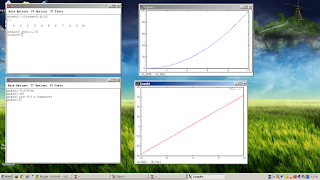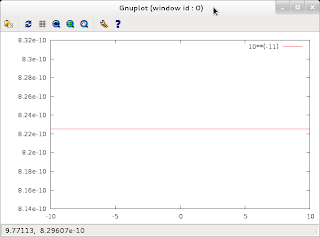In part 1, I showed you how to export MS data (MS= Mass Spectrometer/ry):
http://verahill.blogspot.com.au/2013/07/474-exporting-data-from-wsearch32-and.html
In part 2, I showed you how to generate theoretical isotopic envelopes, and how to compare them with observed ones:
http://verahill.blogspot.com.au/2013/07/480-ms-data-part-ii-plotting-and.html
In part 3, I showed you how to make contour plots of '3D' data -- in that particular case the extra dimension was cone voltage, but it could just as easily have been time:
http://verahill.blogspot.com.au/2013/07/ms-data-part-iii-generating-matrix-by.html
In part 4, we'll use the same data as in part 3, but we'll make a stacked plot of it. This is a short post.
There is at least one other way of making a stacked plot in gnuplot, but it doesn't yield what I'd consider as being publication quality plots. It's also fairly restrictive in the type of data can be plotted. The method shown here is general and applicable to all types of data. You can
e.g. use it for time-dependent NMR data...
Here's an example of a gnuplot script:
### Preamble start
set term png size 1000,500
set output 'stack.png'
set border 1
set xtics nomirror
set ytics nomirror
unset ytics
set xrange [100:3000]
set yrange [0:100]
set multiplot
set size 0.85,0.45
unset key
### Preamble over
### The stacked plot
set origin 0,0
set label "m/z" at 1500, -18
plot '0.dat' with lines lt -1
# we want the x axis to show ONLY for the first spectrum,
# so we turn it off for the remaining spectra.
# The same goes for our label (xlabel can be tricky
# to position correctly)
unset label
set border 0
unset xtics
unset ytics
# Here we set the spacing (fx) the initial position of the second spectrum (f),
# the initial horizontal offset of the second spectrum relative to the first one (g),
# and the horizontal offset for all subsequent spectra (gy)
f=0.0025
fx=0.00
g=0.01
gy=0.02
# then we plot all the other spectra
set origin fx+0*f,gy+0*g
plot '10.dat' with lines lt -1
set origin fx+1*f,gy+1*g
plot '20.dat' with lines lt -1
set origin fx+2*f,gy+2*g
plot '30.dat' with lines lt -1
set origin fx+3*f,gy+3*g
plot '40.dat' with lines lt -1
set origin fx+4*f,gy+4*g
plot '50.dat' with lines lt -1
set origin fx+5*f,gy+5*g
plot '60.dat' with lines lt -1
set origin fx+6*f,gy+6*g
plot '70.dat' with lines lt -1
set origin fx+7*f,gy+7*g
plot '80.dat' with lines lt -1
set origin fx+8*f,gy+8*g
plot '90.dat' with lines lt -1
set origin fx+9*f,gy+9*g
plot '100.dat' with lines lt -1
set origin fx+10*f,gy+10*g
plot '110.dat' with lines lt -1
set origin fx+11*f,gy+11*g
plot '120.dat' with lines lt -1
set origin fx+12*f,gy+12*g
plot '130.dat' with lines lt -1
set origin fx+13*f,gy+13*g
plot '140.dat' with lines lt -1
set origin fx+14*f,gy+14*g
plot '150.dat' with lines lt -1
set origin fx+15*f,gy+15*g
plot '160.dat' with lines lt -1
set origin fx+16*f,gy+16*g
plot '170.dat' with lines lt -1
set origin fx+17*f,gy+17*g
plot '180.dat' with lines lt -1
set origin fx+18*f,gy+18*g
plot '190.dat' with lines lt -1
set origin fx+19*f,gy+19*g
plot '200.dat' with lines lt -1
set origin fx+20*f,gy+20*g
plot '210.dat' with lines lt -1
set origin fx+21*f,gy+21*g
plot '220.dat' with lines lt -1
set origin fx+22*f,gy+22*g
plot '230.dat' with lines lt -1
set origin fx+23*f,gy+23*g
plot '240.dat' with lines lt -1
set origin fx+24*f,gy+24*g
plot '250.dat' with lines lt -1
set origin fx+25*f,gy+25*g
plot '260.dat' with lines lt -1
set origin fx+26*f,gy+26*g
plot '270.dat' with lines lt -1
set origin fx+27*f,gy+27*g
plot '280.dat' with lines lt -1
set origin fx+28*f,gy+28*g
plot '290.dat' with lines lt -1
set origin fx+29*f,gy+29*g
plot '300.dat' with lines lt -1
and here's the plot:
If you want to make it really fancy, try this:
### Preamble start
set term png size 1000,800
set output 'stack.png'
set border 1
set xtics nomirror
set ytics nomirror
unset ytics
set xrange [100:3000]
set yrange [0:100]
set multiplot
set size 0.85,0.25
unset key
### Preamble over
### The stacked plot
set origin 0,0
set label "m/z" at 1500, -18
plot '0.dat' with lines lt -1
# we want the x axis to show ONLY for the first spectrum,
# so we turn it off for the remaining spectra.
# The same goes for our label (xlabel can be tricky
# to position correctly)
unset label
set border 0
unset xtics
unset ytics
# Here we set the spacing (fx) the initial position of the second spectrum (f),
# the initial horizontal offset of the second spectrum relative to the first one (g),
# and the horizontal offset for all subsequent spectra (gy)
f=0.0025
fx=0.00
g=0.01
gy=0.02
# then we plot all the other spectra
set origin fx+0*f,gy+0*g
plot '10.dat' with lines lt -1
set origin fx+1*f,gy+1*g
plot '20.dat' with lines lt -1
set origin fx+2*f,gy+2*g
plot '30.dat' with lines lt -1
set origin fx+3*f,gy+3*g
plot '40.dat' with lines lt -1
set origin fx+4*f,gy+4*g
plot '50.dat' with lines lt -1
set origin fx+5*f,gy+5*g
plot '60.dat' with lines lt -1
set origin fx+6*f,gy+6*g
plot '70.dat' with lines lt -1
set origin fx+7*f,gy+7*g
plot '80.dat' with lines lt -1
set origin fx+8*f,gy+8*g
plot '90.dat' with lines lt -1
set origin fx+9*f,gy+9*g
plot '100.dat' with lines lt -1
set origin fx+10*f,gy+10*g
plot '110.dat' with lines lt -1
set origin fx+11*f,gy+11*g
plot '120.dat' with lines lt -1
set origin fx+12*f,gy+12*g
plot '130.dat' with lines lt -1
set origin fx+13*f,gy+13*g
plot '140.dat' with lines lt -1
set origin fx+14*f,gy+14*g
plot '150.dat' with lines lt -1
set origin fx+15*f,gy+15*g
plot '160.dat' with lines lt -1
set origin fx+16*f,gy+16*g
plot '170.dat' with lines lt -1
set origin fx+17*f,gy+17*g
plot '180.dat' with lines lt -1
set origin fx+18*f,gy+18*g
plot '190.dat' with lines lt -1
set origin fx+19*f,gy+19*g
plot '200.dat' with lines lt -1
set origin fx+20*f,gy+20*g
plot '210.dat' with lines lt -1
set origin fx+21*f,gy+21*g
plot '220.dat' with lines lt -1
set origin fx+22*f,gy+22*g
plot '230.dat' with lines lt -1
set origin fx+23*f,gy+23*g
plot '240.dat' with lines lt -1
set origin fx+24*f,gy+24*g
plot '250.dat' with lines lt -1
set origin fx+25*f,gy+25*g
plot '260.dat' with lines lt -1
set origin fx+26*f,gy+26*g
plot '270.dat' with lines lt -1
set origin fx+27*f,gy+27*g
plot '280.dat' with lines lt -1
set origin fx+28*f,gy+28*g
plot '290.dat' with lines lt -1
set origin fx+29*f,gy+29*g
plot '300.dat' with lines lt -1
### second plot
set size 0.75,0.4
set origin 0.1,0.6
set xrange [800:1800]
set border 3
set xtics nomirror
set ytics nomirror
set xlabel 'm/z'
set ylabel 'Relative abundance (%)'
set title '20 V'
plot '20.dat' with lines lt -1
unset multiplot
which looks like this:















